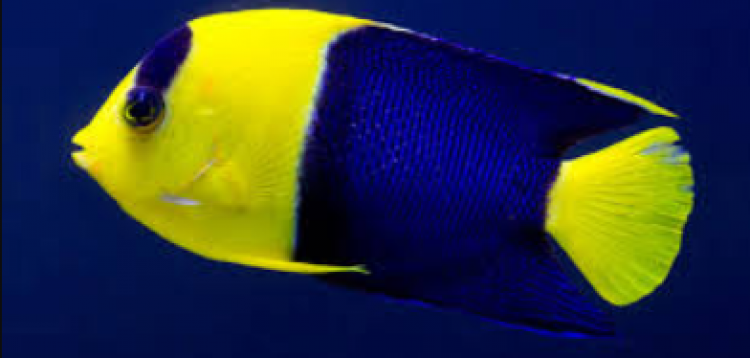- Name:
Flagfin Angelfish
(View AKA's) - Family: Pomacanthidae
- Species: Angel Large
- Scientific Name: Apolemichthys trimaculatus


General info about Flagfin Angelfish
The Flagfin Angelfish is a brilliant yellow with blue lips, a dark blue-black dorsal spot where the head joins the body, and a light tan spot behind the eye. Provide plenty of other hiding places in a large as the Flagfin Angelfish is quite shy early on and should be the only angel in the tank. Not a good reef dweller, the Flagfin Angelfish is prone to nip at sessile invertebrates (soft and stony corals) and clam mantles.
Flagfin Angelfish Diet & Nutrition
It is an omnivore that primarily eats sponges and tunictaes along with algae. It is best to supplement tank with mysis or brine shrimp to intitiate feeding response on the fish when first introduced in the tank. Once acclimated, prepared food such as those containing spirulina, sponge, algae sheets, chopped fish and shrimp should be provided in small amounts several times per day.
Determining Sex of Flagfin Angelfish
Flagfin angelfish does not show distinct sexual dimorphism. However, males tend to be larger than females.
Breeding & Spawning Flagfin Angelfish
Flagfin angelfish has been reported to successfully spawn in large public aquarium. These large angelfishes are usually broadcast spawners releasing sperm and eggs at sunset. Courtship for this species usually occurs at dusk, this then progresses to an ascent to the water column by the males followed by females which eventually lead to the release of gametes in the water column for external fertilization. During courtship the male will trail behind the female positioning his snout to near the female's abdomen.
Common Diseases with Flagfin Angelfish
In captivity,Flagfin Angelfishes are prone to ite Spot Disease and Velvet Disease which causes blotchy coloration on the dark skin areas. It is also suscetible to viral infection like Lymphocystis which is the formation of cauliflower-shaped nodules on the fins and mouth keeping them from eating properly.
Flagfin angelfishes may also contract monogenetic flukes.
Flagfin Angelfish Origin
Apolemichthys trimaculata or Flagfin angelfish are highly distributedi n the Indo-West Pacific covering the south eastern coast of Africa to Samoa, southern part of Japan towards Australia's northern coasts and islands.
Caution with Flagfin Angelfish
These angelfish are quite difficult to keep as they are extremely timid and easily stressed. They can be kept in a community aquarium with peaceful tankmates provided that it is large enough to avoid aggressive behavior towards other angelfish in the tank.
Acclimating Flagfin Angelfish
Tanks should be mature, at least 6 months, provided with live rocks for feeding and hiding place before introducing a Flagfin Angelfish in it.
Original Detail
| Name | Species | Family | Scientific Name | More Detail | Added by |
|---|---|---|---|---|---|
| Flagfin Angelfish | Angel Large | Pomacanthidae | Apolemichthys trimaculatus | The Flagfin Angelfish is a brilliant yellow with blue lips, a dark blue-black dorsal spot where the head joins the body, and a light tan spot behind the eye. Provide plenty of other hiding places in a large as the Flagfin Angelfish is quite shy early on and should be the only angel in the tank. Not a good reef dweller, the Flagfin Angelfish is prone to nip at sessile invertebrates (soft and stony corals) and clam mantles. |
PalaciosAn |
Changed by users
| Submitted Date | Submitted By | Status | Action |
|---|



